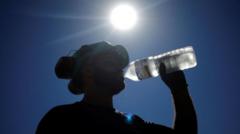In a recent report, the World Health Organization (WHO) and the World Meteorological Organization (WMO) have highlighted the increasing risk of heat stress for workers as climate change leads to more frequent and severe heatwaves. Millions are currently exposed to potentially harmful working conditions, particularly in sectors like construction and agriculture. The WHO warns that high temperatures not only contribute to health risks—like dehydration and heat-related illnesses—but also decrease productivity. For every degree Celsius above 20°C, productivity can drop by 2%.
This marks the WHO's first report focusing on heat stress at work since 1969, signaling how urgent the issue has become. With the last decade recording unprecedented temperatures, adaptation strategies must be devised in collaboration with employers, governments, and workers to safeguard health and work output. Newly introduced measures in countries like Italy and Switzerland aim to pause work during peak heat times.
In addition, the elderly and children are particularly vulnerable during heatwaves, raising concerns for schools as well. Suggestions have been made for educational institutions to adapt by improving ventilation and introducing more flexible learning environments during extreme heat.
Despite the clear need for investment in adaptation, many governments are prioritizing defense over climate action, a decision the WHO warns could lead to greater long-term costs through lost productivity and adverse health outcomes. Now is the time for communities and workplaces to collaborate for safer, healthier environments amid the rising temperatures we now face.
This marks the WHO's first report focusing on heat stress at work since 1969, signaling how urgent the issue has become. With the last decade recording unprecedented temperatures, adaptation strategies must be devised in collaboration with employers, governments, and workers to safeguard health and work output. Newly introduced measures in countries like Italy and Switzerland aim to pause work during peak heat times.
In addition, the elderly and children are particularly vulnerable during heatwaves, raising concerns for schools as well. Suggestions have been made for educational institutions to adapt by improving ventilation and introducing more flexible learning environments during extreme heat.
Despite the clear need for investment in adaptation, many governments are prioritizing defense over climate action, a decision the WHO warns could lead to greater long-term costs through lost productivity and adverse health outcomes. Now is the time for communities and workplaces to collaborate for safer, healthier environments amid the rising temperatures we now face.
















